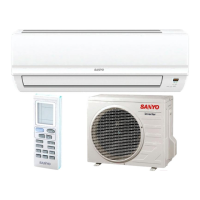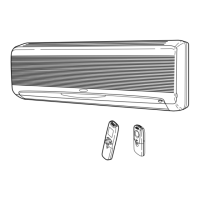What to do if fan motor rotation speed does not change during indoor unit operation of my Sanyo SAP-KRV96EHDS?
- AAndrew CowanSep 10, 2025
If the fan motor rotation speed does not change during indoor unit operation, replace the controller.

What to do if fan motor rotation speed does not change during indoor unit operation of my Sanyo SAP-KRV96EHDS?
If the fan motor rotation speed does not change during indoor unit operation, replace the controller.
What to do if fan motor rotation speed varies excessively during outdoor unit operation of my Sanyo SAP-KRV96EHDS?
If the fan motor rotation speed varies excessively during outdoor unit operation, replace the controller.
What to do if fan motor rotation speed varies excessively during indoor unit operation of my Sanyo SAP-KRV96EHDS?
If the fan motor rotation speed varies excessively during indoor unit operation, replace the controller.
Why is the indoor unit operation lamp blinking on my Sanyo SAP-KRV96EHDS?
The indoor unit operation lamp blinking every 0.5 seconds indicates an external ROM (OTP data) failure on the indoor circuit board, a ROM socket insertion problem, or the ROM hasn't been installed. Ensure the ROM is properly installed.
| Power Supply | 220-240V, 50Hz |
|---|---|
| Refrigerant | R410A |
| Type | Split |
| Capacity | 2.5kW |
| Cooling Capacity | 2.5kW |
| Heating Capacity | 2.8kW |
| Operating Temperature (Cooling) | 18°C to 43°C |
| Operating Temperature (Heating) | -7°C to 24°C |
| Outdoor Unit Noise Level | 50 dB |
Lists indoor/outdoor models, RoHS compliance, and refrigerant type.
Essential steps for proper setup and safe use, including reading the manual and observing codes.
Safety measures for wiring, transport, installation, servicing, and general use.
Defines operational temperature ranges for cooling and heating modes.
Detailed technical data for indoor and outdoor units, including performance and electrical ratings.
Specifics on control PCB, fan, motors, and heat exchanger for indoor units.
Details on control PCB, compressor, fan, and heat exchanger for outdoor units.
Sensor specifications with resistance-temperature graphs.
Technical drawings showing the size and configuration of the indoor unit.
Technical drawings illustrating the size and configuration of the outdoor unit.
Visual representation of refrigerant flow and insulation requirements for tubing.
Graphs showing performance metrics at various temperature conditions.
Charts illustrating airflow distance based on flap angle and fan speed.
Technical data on running current, power input, and voltage for unit operation.
Schematics detailing electrical connections for the indoor unit.
Guidelines for choosing an optimal and safe location for the indoor unit.
Recommendations for selecting a suitable location for the outdoor unit.
Guidance on selecting appropriate wire sizes and lengths for power supply.
Advice on ideal placement for the remote control unit for optimal signal reception.
Step-by-step instructions for performing a test run of the air conditioner.
Procedures for safely removing and reattaching the indoor unit's front grille.
How to set or change the address for multi-unit systems.
Steps for removing and mounting the drain hose and removing the indoor unit grille.
Detailed steps for removing the electrical component box assembly.
Procedures for removing the main circuit board and panel motor.
Steps to remove the UV unit for maintenance or replacement.
Procedures for mounting the UV unit and removing the drain pan.
Instructions for disassembling and reassembling the fan motor.
Steps to safely remove the fan from the indoor unit assembly.
Guide on how to disconnect and connect electrical connectors on the outdoor unit.
Explains emergency, auto, sensor dry, and PAM-a control modes.
Details on overload, freeze, and compressor temperature protection mechanisms.
Essential safety steps and considerations before performing any inspection or repair.
Procedure to initiate and interpret the unit's self-diagnostic system.
Steps to check for proper operation of indoor and outdoor units.
Guide to diagnose communication errors between indoor and outdoor units.
Diagnosing issues related to the indoor unit's DC fan motor.
Diagnosing problems with the outdoor unit's DC fan motor.
Identifying and resolving issues caused by external noise and EMI.
Steps to check and fix issues with the front panel's operation.
Procedure for checking the panel motor's coil resistance.
Guide on how to measure insulation resistance of power cords and unit components.
Steps to check the continuity of fuses on the PCB assembly using a multimeter.
Information on R410A composition, characteristics, and essential servicing precautions.
Key checks and precautions to follow before performing service on R410A systems.
Recommended tools for R410A servicing and procedures for tubing installation.
Steps for diagnosing compressor issues and replacing the unit.
Procedures for finding, repairing, and recharging refrigerant leaks.
Guidelines for charging additional refrigerant and retrofitting existing systems.
Information needed for model, serial number, and purchase details.
Defines the meaning of warning and caution symbols in the manual.
Recommendations for optimal and safe placement of the air conditioner.
Wiring standards, grounding, and safety for electrical installation.
Diagrams labeling the main parts of the indoor and outdoor units.
Guide on how to insert and replace batteries in the remote control.
Advice on where to install the wall mount for optimal signal reception.
Instructions for proper handling and aiming of the remote control unit.
How the unit automatically selects cooling or heating based on room temp.
Step-by-step guide for manual control of operation mode, temp, fan, and flap.
Setting fan speed manually or automatically.
Operating the unit for air circulation without cooling or heating.
Energy-saving feature for comfortable sleep, adjusting temp automatically.
Reduces fan speed for quieter operation.
Boosts cooling/heating output for 30 minutes for rapid temperature change.
Activates UV anti-bacteria unit for air purification.
Specifics on dry mode operation, including fan speed and temperature limits.
Notes on heating efficiency at low temperatures and the defrosting system.
Information on cold draft prevention, cooling operation limits, and power failure restart.
Procedure to set the current time on the remote control display.
Programming the unit to turn off at a specified time.
Programming the unit to turn on at a specified time.
Setting recurring daily start and stop times.
Function to automatically stop the unit one hour after activation.
Recommendations for efficient operation and energy conservation.
Manually directing airflow horizontally using vertical vanes.
Adjusting vertical airflow direction using the flap via remote.
Explains sweep, manual flap positions, and auto flap functions.
How to operate the unit directly and clean the front panel.
Procedures for removing, replacing, and cleaning the anti-mold filter.
Guidelines for cleaning the casing, grille, and internal components.
How to install and maintain the air clean filter.
Troubleshooting tips for issues related to operating range and performance.












